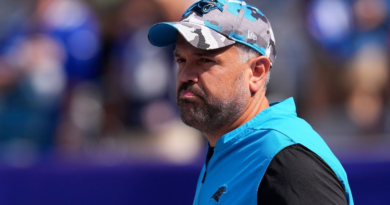The oldest and the youngest teams in 2023-24
In 2012, Kentucky won a national championship with a roster headlined by first-year stars Anthony Davis, Michael Kidd-Gilchrist and Marquis Teague. Three years later, Duke followed more or less that same path, with Jahlil Okafor, Justise Winslow and Tyus Jones.
The NBA eligibility rules that made those Wildcats and Blue Devils teams possible are still with us. One-and-done is still here, as demonstrated most recently by players like Brandon Miller, Jarace Walker and Jalen Hood-Schifino. The most talented 18-year-old players in the world are still required to play one more year somewhere other than the NBA before they’re eligible for the draft.
So why do we hear less about one-and-done today and more about the paramount importance of “experience”? Possibly, this shift reflects the fact that recent champions have skewed older. Chalk this up to two changes made by the NCAA.
For starters, the adoption of a one-time transfer rule in 2021 changed the landscape of recruiting dramatically. Where coaches once focused their efforts primarily on high school talent, the increasing importance of the transfer portal has convinced some observers that we are now in “the portal era.”
In addition, we still see the impact of the NCAA’s decision in October 2020 to grant an extra year of eligibility in response to the COVID-19 pandemic. Basketball players who arrived on campus in the fall of 2019, for example, are still eligible to use that extra season if they wish. The newcomers of 2019-20 are often today’s fifth-year seniors.
Forecasting rotation ages for 2024
As a result of these changes by the NCAA, the population of Division I men’s players is both more mobile and, in all likelihood, older than it used to be. How might we see these trends play out at the top of the league in 2024 in terms of average age weighted by playing time?
To address this question, we’ll borrow from excellent work already done by others. Our ESPN.com colleague Jeff Borzello has helpfully ranked the top 25 men’s college basketball teams for 2023-24. Not to be outdone, Bart Torvik has bravely estimated how many minutes each player in D-I will record next season.
Before we begin, however, two warnings are in order. First, just because the NBA’s early-entry withdrawal deadline has come and gone doesn’t mean we know in June what rosters will really look like in November. Players are still on the move.
Second, projections of minutes played are just that: projections. For all we know, a few previously underrated first-year players will earn surprisingly heavy minutes. Treat the following discussion with all due caution.
Kansas could be seriously old
Working from Mr. Borzello’s preseason top 25 and Mr. Torvik’s projections for minutes played, we find no fewer than 11 teams clocking in with an average age weighted for minutes (AAWM) of 22.0 or older. (See below for full rankings.)
Congratulations to Villanova, the oldest of the bunch with a projected AAWM of 22.8. Mainstays Justin Moore and Eric Dixon logged heavy minutes back in the Jay Wright days. This season, they will be joined by veterans like Richmond transfer Tyler Burton, who celebrates his 24th birthday in February.
Perhaps the real age news, however, is found elsewhere in the rankings. Kansas is No. 1 in the Borzello top 25 and also nets out as No. 3 for expected age. Bill Self’s group is projected to have a 22.6 AAWM this coming season. Among Borzello’s top 25, only Villanova and Arkansas project to be older.
Assume for the moment that the Jayhawks reach the 2024 NCAA tournament (and yes, do ask North Carolina about 2022-23 and assumptions). Featured players Dajuan Harris Jr., Kevin McCullar Jr. and Hunter Dickinson would all enter the round of 64 as 23-year-olds. Then again, all of the above will be mere youngsters compared to teammate Nick Timberlake. The Towson transfer will by that time be five months shy of his 26th birthday.
Kentucky looks about as young as it did in the ‘old days’
At the other end of the projected age spectrum for 2024, we find two familiar names: Kentucky and Duke. The Wildcats in particular show a young look, with a projected AAWM of 20.2.
For comparison’s sake, the 2012 national championship UK team sported a 19.7 AAWM. While Duke in 2015 was similarly positioned demographically (20.1), recent champions have skewed toward “average” (UConn last season at 21.3) or even “old” (Baylor and Kansas in 2021 and 2022 were both over 22.0).
As for the Blue Devils, a projected 20.8 AAWM in 2024 does appear youthful compared to other Borzello top-25 selections. On the other hand, Jon Scheyer’s group is likely to be measurably older than the 2021-22 Duke team (20.0) that came within five points of reaching the national championship game. Which leads to one last reminder …
… Age isn’t everything
The oldest team in the 2023 Sweet 16 was San Diego State (23.0) — a fact that did not prevent UConn from trouncing the Aztecs in the national title game.
The oldest team in recent memory was Providence in 2021-22 (23.3), a fact that did not prevent the Friars from bowing out against Kansas in that year’s Sweet 16.
Age is a significant factor in college basketball because players improve year-to-year in their late teens and early 20s. But of course we’ve seen this particular form of significance rendered relatively insignificant many, many times. Anyone who saw Kevin Durant as an 18-year-old at Texas understands that age isn’t everything in college hoops.
Nevertheless, it’s possible age will carry a bit more weight as the trend toward older teams continues. If that turns out to be the case, keep an eye on seasoned teams like Kansas in 2023-24.




